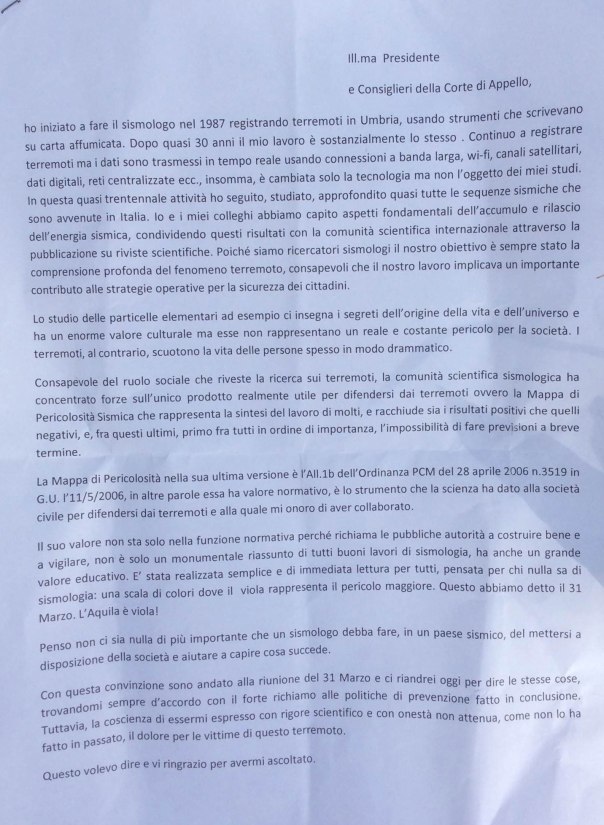Blog Archives
Ultima udienza del processo di Appello: dichiarazioni di Giulio Selvaggi
Stamattina si è tenuta l’ultima udienza del processo di Appello a L’Aquila.
Nella fase iniziale, prima degli avvocati difensori, ha parlato il nostro collega Giulio Selvaggi rilasciando la dichiarazione che riportiamo in foto.
La presidente della Corte di Appello a fine mattinata ha annunciato la sentenza tra le ore 16 e 17 di oggi.
Giulio Selvaggi statement at the hearing this morning
I started my career in Seismology in 1987, recording earthquakes in Umbria with instruments that used smoked paper. After almost thirty years my job is substantially the same. I still record earthquakes but now data are transmitted in real time using broad band connections, wifi, satellite channels, digital data, centralized networks, etc., thus only the technology has changed but not the goal of my studies. During these thirty years, I have studied in detail most of the seismic sequences that occurred in Italy. My colleagues and I have understood fundamental aspects related to the loading and the release of the seismic energy, sharing these results with the international scientific community through publication on international scientific journals. As researchers in seismology, our goal has always been advancing the understanding of earthquake process, aware that our work implied an important contribution to the operational choices for citizens’ safety.
The study of the elementary particles, for instance, teaches us the secrets of the origin of life and universe and has an enormous cultural value. However, this kind of research has not a direct impact on the safety of the society. Earthquakes, on the contrary, shake people’s life often dramatically.
Being aware of the social role of the earthquake research, the seismological scientific community has concentrated its efforts on the only useful target in order to mitigate earthquake risk, that is the seismic hazard map. It represents the synthesis of the work of many scientists and includes both positive and negative results. Among the latter, first of all, the impossibility to carry out short term earthquake predictions.
The most recent version of the seismic hazard map is the attachment no. 1 of the Prime Minister Ordinance (April 28 2006 no. 3519, published in the Official Gazette of the Italian State in May 11, 2006). In other words, the map – to which I am honored to have collaborated – has a regulatory value and represents the best tool provided by science to society in order to perform a modern defence against the earthquakes.
The value of the map relies not only in its regulatory function -it imposes the public authorities to construct safe buildings- but also on its fundamental educational value. It has been done in a simple way and for an easy reading, thought for people who do not know anything about seismology: a colour scale where the purple represents the highest hazard. That is what we said on March 31: L’Aquila is purple!
I think there is nothing more important for a seismologist in a seismic country than service the society to understand what’s going on.
With this belief I went to the meeting on March 31 and I would go there again today to state the same things, always agreeing with the statement made at the end of that meeting reminding and underlying the importance of prevention. However, the conscience of having spoken with scientific rigour and with honesty does not attenuate, as in the past, my grief for the victims of this earthquake.
This is what I wanted to say and I thank you all for listening to me.
The sentence is expected at 5 p.m.

You must be logged in to post a comment.